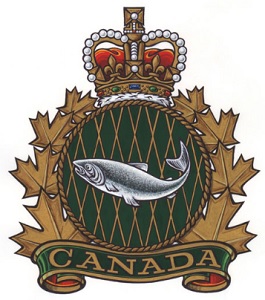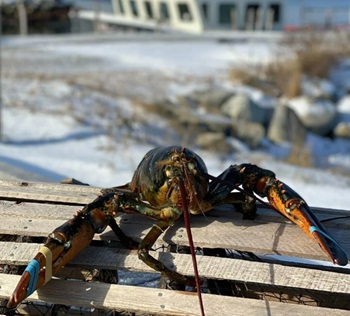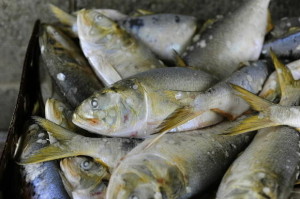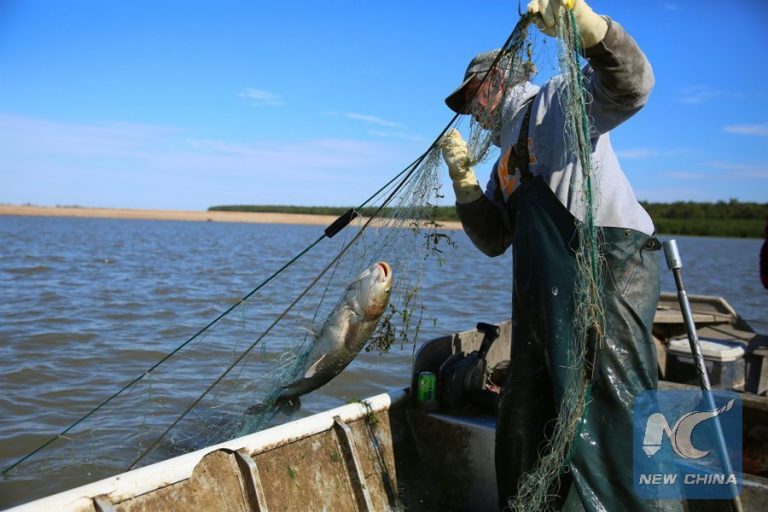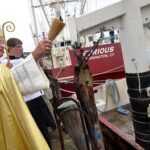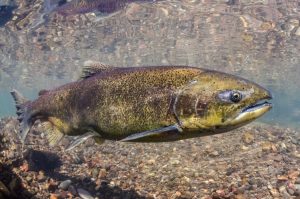Tag Archives: Nova Scotia
Lobster harvesters in Atlantic Canada to vote on increasing minimum legal size this year
 At stake is maintaining access to the United States market. “It will be an individual vote. That’s a big decision that every single enterprise and owner has to look at from their own business,” said Heather Mulock, executive director of the Coldwater Lobster Association, which represents fishermen in lobster fishing area 34 (LFA 34). In late May or June, the 979 licence holders in the area will be asked to vote on whether to match increases in allowable U.S. catch measurements that will come into effect Jan. 1, 2025, and again in 2027. Live Canadian lobster that fall under the new limits would not be allowed into the U.S. That includes bonded shipments of lobster under the new minimum in the U.S., according to an information package sent to fishermen in southwestern Nova Scotia. That could block trucking of “undersized” Canadian lobster across the border for flights to Asia from airports in Boston or New York. more, >>click to read<< 08: 57
At stake is maintaining access to the United States market. “It will be an individual vote. That’s a big decision that every single enterprise and owner has to look at from their own business,” said Heather Mulock, executive director of the Coldwater Lobster Association, which represents fishermen in lobster fishing area 34 (LFA 34). In late May or June, the 979 licence holders in the area will be asked to vote on whether to match increases in allowable U.S. catch measurements that will come into effect Jan. 1, 2025, and again in 2027. Live Canadian lobster that fall under the new limits would not be allowed into the U.S. That includes bonded shipments of lobster under the new minimum in the U.S., according to an information package sent to fishermen in southwestern Nova Scotia. That could block trucking of “undersized” Canadian lobster across the border for flights to Asia from airports in Boston or New York. more, >>click to read<< 08: 57
Mi’kmaw fishers say DFO officers left them to walk for hours at night after seizing boots, phones
 Two Mi’kmaw elver fishermen say they were forced to walk in sock feet for hours along a rural Nova Scotia highway in the middle of the night last week after they were detained by federal fisheries officers who took their boots and phones before releasing them. Blaise Sylliboy and Kevin Hartling, who assert they have a treaty right to fish for the lucrative baby eels despite this year’s season being cancelled, were joined Tuesday morning by dozens of protesters outside the Department of Fisheries and Oceans building in Dartmouth, N.S. “When we were walking, there’s times I’m like, ‘Man, if we stop, we’re going to die,’ because our feet were just soaked,” said Hartling. more, >>click to read<< 06:22
Two Mi’kmaw elver fishermen say they were forced to walk in sock feet for hours along a rural Nova Scotia highway in the middle of the night last week after they were detained by federal fisheries officers who took their boots and phones before releasing them. Blaise Sylliboy and Kevin Hartling, who assert they have a treaty right to fish for the lucrative baby eels despite this year’s season being cancelled, were joined Tuesday morning by dozens of protesters outside the Department of Fisheries and Oceans building in Dartmouth, N.S. “When we were walking, there’s times I’m like, ‘Man, if we stop, we’re going to die,’ because our feet were just soaked,” said Hartling. more, >>click to read<< 06:22
N.L. protest cause rooted in price-setting systems for fishers and processors
 The protest that erupted Wednesday outside the legislature in Newfoundland and Labrador has its roots in a complex, years-long struggle between independent fish harvesters and processors over the price-setting system, industry observers say. Sean Cadigan, a professor of history at Memorial University, said in an interview Thursday that one underlying factor in the tensions is the plunge in prices for snow crab, the province’s most valuable seafood export. From highs of over seven dollars per pound during the pandemic, the price fell to about two dollars per pound last year, creating hardships for harvesters at a time harvesters’ expenses are rising. He said that has combined with long-standing suspicions that harvesters have toward the small group of companies that dominate fish processing in the province. more, >>click to read<< 07:40
The protest that erupted Wednesday outside the legislature in Newfoundland and Labrador has its roots in a complex, years-long struggle between independent fish harvesters and processors over the price-setting system, industry observers say. Sean Cadigan, a professor of history at Memorial University, said in an interview Thursday that one underlying factor in the tensions is the plunge in prices for snow crab, the province’s most valuable seafood export. From highs of over seven dollars per pound during the pandemic, the price fell to about two dollars per pound last year, creating hardships for harvesters at a time harvesters’ expenses are rising. He said that has combined with long-standing suspicions that harvesters have toward the small group of companies that dominate fish processing in the province. more, >>click to read<< 07:40
Snow crab price talks have broken off, FFAW says
 Protest leader John Efford Jr. grabbed a megaphone Thursday to told the crowd that negotiations for a new crab price-setting formula had broken off ahead of the upcoming season. “There’s no agreement to be made,” he told the cheering crowd. “And how can you make an agreement when you’re trying to make an agreement with a colluded cartel that has the support of the government?” While the price-setting process has been controversial in the past, it hasn’t been at the core of the protests outside the province’s legislature this week. The Fish, Food & Allied Workers union and the Association of Seafood Processors have been working with the provincial government to establish a new formula to determine the price. more, >>click to read<< 17:12
Protest leader John Efford Jr. grabbed a megaphone Thursday to told the crowd that negotiations for a new crab price-setting formula had broken off ahead of the upcoming season. “There’s no agreement to be made,” he told the cheering crowd. “And how can you make an agreement when you’re trying to make an agreement with a colluded cartel that has the support of the government?” While the price-setting process has been controversial in the past, it hasn’t been at the core of the protests outside the province’s legislature this week. The Fish, Food & Allied Workers union and the Association of Seafood Processors have been working with the provincial government to establish a new formula to determine the price. more, >>click to read<< 17:12
Police don riot gear as Furey’s Liberals make 2nd attempt at budget amid protests
 It’s deja vu at Confederation Building in St. John’s on Thursday morning, as police and protesters have shown up in large numbers ahead of the Newfoundland and Labrador government’s plans to introduce the 2024 budget. By 6 a.m. NT, dozens of Royal Newfoundland Constabulary officers — some in riot gear — were standing guard in front of the main entrances to the building and a growing number of fish harvesters were arriving on scene. Police were seen having a cordial conversation with protest leaders, urging them to avoid a repeat of Wednesday’s raucous events — particularly with a court-ordered injunction now in place that prohibits protesters from blocking safe access to Confederation Building, which is both home to the legislature and the main government complex. Protest leader John Efford Jr. addressed the crowd a few minutes later. Photos, Video, more, >>click to read<< 06:24
It’s deja vu at Confederation Building in St. John’s on Thursday morning, as police and protesters have shown up in large numbers ahead of the Newfoundland and Labrador government’s plans to introduce the 2024 budget. By 6 a.m. NT, dozens of Royal Newfoundland Constabulary officers — some in riot gear — were standing guard in front of the main entrances to the building and a growing number of fish harvesters were arriving on scene. Police were seen having a cordial conversation with protest leaders, urging them to avoid a repeat of Wednesday’s raucous events — particularly with a court-ordered injunction now in place that prohibits protesters from blocking safe access to Confederation Building, which is both home to the legislature and the main government complex. Protest leader John Efford Jr. addressed the crowd a few minutes later. Photos, Video, more, >>click to read<< 06:24
Maritime elver fishery closure penalizes legal fishers, committee hears
 The committee heard from the Canada Border Services Agency, the Canadian Food Inspection Agency, the RCMP, the Canadian Committee for a Sustainable Eel Fishery, and a legal elver fisherman with Shelburne Elver. “I lost my partner to cancer a few months ago,” Zachary Townsend, the elver fisherman, told the committee. “It’s been hard and unbearable at times. But to now be unemployed and facing an uncertain financial future is simply a challenge I didn’t need. “And I don’t share such sad news to vote your pity, but instead to remind you that each of us 1,100 [Maritime elver fishers] has a story and a unique set of circumstances now made worse by the minister.” The elver fishing season was cancelled in Nova Scotia and New Brunswick after Fisheries and Oceans Canada admitted it couldn’t control poaching or the export of baby eels, which sell for thousands of dollars a kilogram. more. >>click to read<< 16:42
The committee heard from the Canada Border Services Agency, the Canadian Food Inspection Agency, the RCMP, the Canadian Committee for a Sustainable Eel Fishery, and a legal elver fisherman with Shelburne Elver. “I lost my partner to cancer a few months ago,” Zachary Townsend, the elver fisherman, told the committee. “It’s been hard and unbearable at times. But to now be unemployed and facing an uncertain financial future is simply a challenge I didn’t need. “And I don’t share such sad news to vote your pity, but instead to remind you that each of us 1,100 [Maritime elver fishers] has a story and a unique set of circumstances now made worse by the minister.” The elver fishing season was cancelled in Nova Scotia and New Brunswick after Fisheries and Oceans Canada admitted it couldn’t control poaching or the export of baby eels, which sell for thousands of dollars a kilogram. more. >>click to read<< 16:42
N.L. government seeks injunction against fishermen amid tense protest at Confederation Building
 The Newfoundland and Labrador government has gone to the Supreme Court to seek an injunction against fish harvesters who swarmed Confederation Building on Wednesday as part of an ongoing protest over fishery regulations that has led to the postponement of the provincial budget. The government announced the postponement after protesters blocked entrances to the building, refused to let government workers inside and had physical confrontations with police officers and horses. A protester complaining of leg pain and a Royal Newfoundland Constabulary officer have been taken from the scene in an ambulance. Protest organizer John Efford Jr. called the budget cancellation historic.”And I have a feeling it may be cancelled again tomorrow, the next business day and the next business day until we get what ? Free enterprise,” he said. Video’s, Photos, more, >>click to read<< 10:53
The Newfoundland and Labrador government has gone to the Supreme Court to seek an injunction against fish harvesters who swarmed Confederation Building on Wednesday as part of an ongoing protest over fishery regulations that has led to the postponement of the provincial budget. The government announced the postponement after protesters blocked entrances to the building, refused to let government workers inside and had physical confrontations with police officers and horses. A protester complaining of leg pain and a Royal Newfoundland Constabulary officer have been taken from the scene in an ambulance. Protest organizer John Efford Jr. called the budget cancellation historic.”And I have a feeling it may be cancelled again tomorrow, the next business day and the next business day until we get what ? Free enterprise,” he said. Video’s, Photos, more, >>click to read<< 10:53
Fisheries minister commits to lifting processing caps, looking for outside buyers ahead of 2024 crab season
 Fisheries Minister Elvis Loveless says he’s willing to meet some of the demands tabled by fish harvesters and their union amid continued protests. In a letter written to the Fish, Food and Allied Workers union on Tuesday — and on the eve of announcing the provincial budget for 2024 — Loveless told union president Greg Pretty the province is committed to raising processing capacity “in the primary processing sector” prior to the start of the 2024 fishery. However, the extent of the increase will be informed, in part, by the total allowable catch that is yet to be announced by the federal fisheries minister. Further, Loveless said his department will issue an expression of interest for outside buyers for the 2024 snow crab fishery on Tuesday. more, >>click to read<< 15:44
Fisheries Minister Elvis Loveless says he’s willing to meet some of the demands tabled by fish harvesters and their union amid continued protests. In a letter written to the Fish, Food and Allied Workers union on Tuesday — and on the eve of announcing the provincial budget for 2024 — Loveless told union president Greg Pretty the province is committed to raising processing capacity “in the primary processing sector” prior to the start of the 2024 fishery. However, the extent of the increase will be informed, in part, by the total allowable catch that is yet to be announced by the federal fisheries minister. Further, Loveless said his department will issue an expression of interest for outside buyers for the 2024 snow crab fishery on Tuesday. more, >>click to read<< 15:44
Cancelling legal elver fishery has not stopped poaching in N.S.
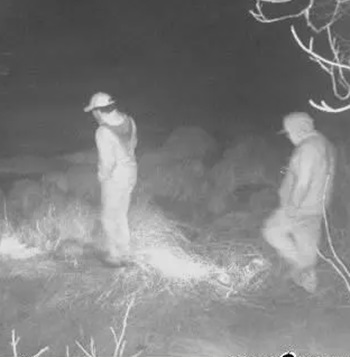 Nova Scotia RCMP have charged a Parrsboro man with multiple criminal counts after a night time altercation with fishery officers attempting to stop illegal elver fishing in Hubbards this weekend. The Department of Fisheries and Oceans says its officers tried to inspect a vehicle on Saturday “as part of their normal activities to deter and disrupt unauthorized elver harvest.” “An individual obstructed fishery officers from conducting the inspection and struck the officers with their vehicle while fleeing to attempt to avoid arrest. “The fishery officers involved were not injured and alerted local RCMP to the incident,” more, >>click to read<< 19:03
Nova Scotia RCMP have charged a Parrsboro man with multiple criminal counts after a night time altercation with fishery officers attempting to stop illegal elver fishing in Hubbards this weekend. The Department of Fisheries and Oceans says its officers tried to inspect a vehicle on Saturday “as part of their normal activities to deter and disrupt unauthorized elver harvest.” “An individual obstructed fishery officers from conducting the inspection and struck the officers with their vehicle while fleeing to attempt to avoid arrest. “The fishery officers involved were not injured and alerted local RCMP to the incident,” more, >>click to read<< 19:03
Ocean Choice sells Nova Scotia offshore scallop quota
 Ocean Choice International has sold its offshore Nova Scotia scallop quotas to three Nova Scotia companies with a long history harvesting sea scallops off the coast of Nova Scotia – Mersey Seafoods Limited, LaHave Seafoods Limited and Comeau’s Sea Foods Limited. ‘We are committed to sustainably growing our place in the fishery in Newfoundland and Labrador; and this decision supports our investment and growth in our business and the fishing industry here at home,’ said Ocean Choice CEO Martin Sullivan. As part of the agreement, Ocean Choice is also acquiring Newfoundland and Labrador offshore quota for Greenland halibut and northern cod from Mersey, and Greenland halibut, northern cod and redfish from LaHave, further strengthening the company’s Newfoundland- and Labrador-based business. more, >>click to read<< 10:21
Ocean Choice International has sold its offshore Nova Scotia scallop quotas to three Nova Scotia companies with a long history harvesting sea scallops off the coast of Nova Scotia – Mersey Seafoods Limited, LaHave Seafoods Limited and Comeau’s Sea Foods Limited. ‘We are committed to sustainably growing our place in the fishery in Newfoundland and Labrador; and this decision supports our investment and growth in our business and the fishing industry here at home,’ said Ocean Choice CEO Martin Sullivan. As part of the agreement, Ocean Choice is also acquiring Newfoundland and Labrador offshore quota for Greenland halibut and northern cod from Mersey, and Greenland halibut, northern cod and redfish from LaHave, further strengthening the company’s Newfoundland- and Labrador-based business. more, >>click to read<< 10:21

Lobster prices hit record high in southwest N.S.
A record high for lobster prices in southwestern Nova Scotia. It’s going for about 19 dollars a pound on the wharf. It’s a great price for captains, but catches are reportedly down this year. Dan Fleck with the Brazil Rock 33/34 Lobster Association says the price is great, but they have to consider the market. “Will some restaurants or buyers in overseas markets take lobster off their menu because it’s being priced out of range? That’s something that’s being dealt with,” said Fleck. more, >> click to read<< 14:28
Climate change risk low to moderate for billion-dollar Nova Scotia lobster fishery, study says
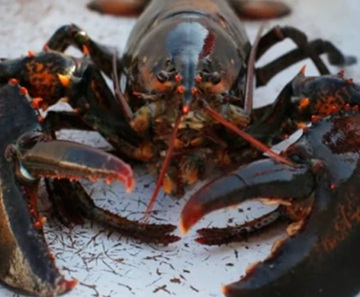 According to a new climate change vulnerability assessment of the billion-dollar Nova Scotia lobster fishery, warming temperatures over the next three decades pose a low to moderate risk for lobsters. “The cumulative outcome suggests that the provincial lobster fishery is largely not at high risk,” says the Centre for Applied Marine Research (CMAR). The provincial government agency undertook the assessment as part of adaptation planning for a key industry. Seafood is Nova Scotia’s largest export with lobster accounting for nearly two thirds of landed value. Seafood landings were valued at $1.65 billion in 2021 more, >>click to read<< 10:38
According to a new climate change vulnerability assessment of the billion-dollar Nova Scotia lobster fishery, warming temperatures over the next three decades pose a low to moderate risk for lobsters. “The cumulative outcome suggests that the provincial lobster fishery is largely not at high risk,” says the Centre for Applied Marine Research (CMAR). The provincial government agency undertook the assessment as part of adaptation planning for a key industry. Seafood is Nova Scotia’s largest export with lobster accounting for nearly two thirds of landed value. Seafood landings were valued at $1.65 billion in 2021 more, >>click to read<< 10:38
Lobster prices at the wharf hit $18 a pound in Nova Scotia
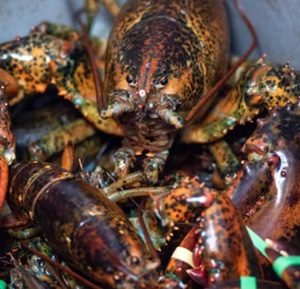 Low catches, low inventory and strong demand are driving the price increase in lobster fishing areas from Halifax to Digby. “It’s surprising, I don’t think anyone expected $18 a pound when the season opened,” said Heather Mulock of the Coldwater Lobster Association, which represents lobster fishermen in southwest Nova Scotia. “There were not a lot of catches and that is reflected in the price.” In Halifax, Sobeys is selling live lobster for $18.99 a pound. Buyer Stewart Lamont of Tangier Lobster fears the high price could bump the crustacean off restaurant menus. more, >>click to read<< 14:32
Low catches, low inventory and strong demand are driving the price increase in lobster fishing areas from Halifax to Digby. “It’s surprising, I don’t think anyone expected $18 a pound when the season opened,” said Heather Mulock of the Coldwater Lobster Association, which represents lobster fishermen in southwest Nova Scotia. “There were not a lot of catches and that is reflected in the price.” In Halifax, Sobeys is selling live lobster for $18.99 a pound. Buyer Stewart Lamont of Tangier Lobster fears the high price could bump the crustacean off restaurant menus. more, >>click to read<< 14:32
Put rules in writing to fix Maritime elver fishery’s enforcement problem, say businesses
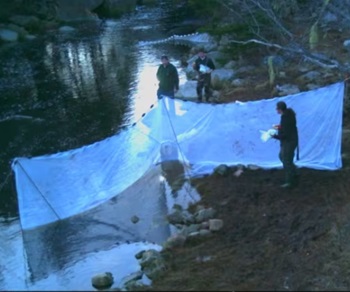 Representatives of the $45-million Maritime elver fishery are calling on the federal government to implement enforceable regulations for moderate livelihood fishing by Indigenous people. They told a Senate committee in Ottawa Thursday the failure to define or regulate moderate livelihood rights by the Department of Fisheries and Oceans (DFO) is one reason for the uncontrolled harvest of baby eels on dozens of rivers in Nova Scotia and New Brunswick. “Among these poachers are First Nations unwilling to work with DFO to access the fishery under a banner of moderate livelihood rights, backed by organized crime, specifically biker gangs and foreign smuggling networks. Our once peaceful industry has recently faced violent disruption,” said Genna Carey, a commercial licence holder speaking on behalf of the Canadian Committee for a Sustainable Eel Fishery, an industry group. more, >>click to read<< 09:29
Representatives of the $45-million Maritime elver fishery are calling on the federal government to implement enforceable regulations for moderate livelihood fishing by Indigenous people. They told a Senate committee in Ottawa Thursday the failure to define or regulate moderate livelihood rights by the Department of Fisheries and Oceans (DFO) is one reason for the uncontrolled harvest of baby eels on dozens of rivers in Nova Scotia and New Brunswick. “Among these poachers are First Nations unwilling to work with DFO to access the fishery under a banner of moderate livelihood rights, backed by organized crime, specifically biker gangs and foreign smuggling networks. Our once peaceful industry has recently faced violent disruption,” said Genna Carey, a commercial licence holder speaking on behalf of the Canadian Committee for a Sustainable Eel Fishery, an industry group. more, >>click to read<< 09:29
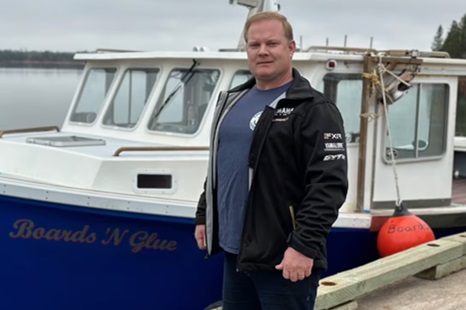
High lobster prices could be a sign of things to come for P.E.I.’s spring fishery
The cost of the crustaceans in most stores is higher than normal for this time of year, running anywhere from $20 to $26 per pound. Most of the lobster caught last year and stored on the Island has already been sold, and fewer boats take part in the winter fishing season in nearby New Brunswick and Nova Scotia. Charlie McGeoghegan, chair of the Lobster Fishers of P.E.I. Marketing Board, said there are only 2,500 boats on the water in Canada right now, compared to 7,000-plus during the spring season. “The boat prices are anywhere from $16.50 to $17.25 — [that’s] what we’re hearing.” more, >>click to read<< 06:50
Commercial Fisherman Scott Dicks of Grand Bank has passed away
 It is with broken hearts that the family of the late Scott Dicks of Grand Bank announces his passing. Scott passed away on the FV Anne Risley in Mulgrave, NS on February 22, 2024 at the age of 36. Leaving to mourn with a lifetime of wonderful memories are the love of his life for 14 years; Nicole; his son, Anthony of Grand Bank; his daughter, Olivia of NB; their daughter, Naomi of Grand Bank; mother, Ellie Keeping; father, Hughie Dicks (Petchie); sister, Tricia (Adam – brother in-law & Best Friend); sister in-law, Nickita Hillier (Jamie); nephews, Addison & Jaxxon; parents in-law, Nick & Sandra House; Best Buddy, Frank; shipmates & work family, crew of the FV Anne Risley; plus a large circle of aunts, uncles, many, many cousins, whom he loved dearly, extended family and friends. more, >>click to read<< 08:55
It is with broken hearts that the family of the late Scott Dicks of Grand Bank announces his passing. Scott passed away on the FV Anne Risley in Mulgrave, NS on February 22, 2024 at the age of 36. Leaving to mourn with a lifetime of wonderful memories are the love of his life for 14 years; Nicole; his son, Anthony of Grand Bank; his daughter, Olivia of NB; their daughter, Naomi of Grand Bank; mother, Ellie Keeping; father, Hughie Dicks (Petchie); sister, Tricia (Adam – brother in-law & Best Friend); sister in-law, Nickita Hillier (Jamie); nephews, Addison & Jaxxon; parents in-law, Nick & Sandra House; Best Buddy, Frank; shipmates & work family, crew of the FV Anne Risley; plus a large circle of aunts, uncles, many, many cousins, whom he loved dearly, extended family and friends. more, >>click to read<< 08:55
With the elver harvesting season on the line, some Mi’kmaw chiefs are scrambling for options
 Fisheries Minister Diane Lebouthillier has said that due to violence, threats, widespread unauthorized harvesting and potential harm to elver stocks the season should be cancelled because it was “not possible to have a safe and sustainable elver fishery.” Key elements of the Mi’kmaw proposal include monitoring total allowable catches, enhancing traceability using GPS and responsibly managing the fishery. It would also double their total allowable catch. Gerald Toney, fisheries co-lead for the Assembly of Nova Scotia Mi’kmaq Chiefs, said communities still need to discuss future plans and whether harvesters will continue to fish even with a ban in place. more, >>click to read<< 08:01
Fisheries Minister Diane Lebouthillier has said that due to violence, threats, widespread unauthorized harvesting and potential harm to elver stocks the season should be cancelled because it was “not possible to have a safe and sustainable elver fishery.” Key elements of the Mi’kmaw proposal include monitoring total allowable catches, enhancing traceability using GPS and responsibly managing the fishery. It would also double their total allowable catch. Gerald Toney, fisheries co-lead for the Assembly of Nova Scotia Mi’kmaq Chiefs, said communities still need to discuss future plans and whether harvesters will continue to fish even with a ban in place. more, >>click to read<< 08:01
Nova Scotia seafood sector far exceeds targets set a decade ago
 Federal Agriculture Minister Lawrence MacAulay was roasted by opponents last week when he posted a photo on X (formerly Twitter) of himself eating a lobster in Malaysia while on a trade mission in the Indo-Pacific. The P.E.I. politician was denounced as tone deaf and out of touch with average Canadians, but overseas trade missions are one reason Nova Scotia seafood exports have exceeded goals set for the industry 10 years ago in the Ivany report — a blueprint for expanding the province’s economy. Veteran seafood analyst Peter Norsworthy, while not weighing in on the optics of the MacAulay image, said seafood exports from Nova Scotia to China have grown from $25 million in 2007 to $666 million in 2021, with almost all of that growth in lobster. Photos, more, >>click to read<< 06:31
Federal Agriculture Minister Lawrence MacAulay was roasted by opponents last week when he posted a photo on X (formerly Twitter) of himself eating a lobster in Malaysia while on a trade mission in the Indo-Pacific. The P.E.I. politician was denounced as tone deaf and out of touch with average Canadians, but overseas trade missions are one reason Nova Scotia seafood exports have exceeded goals set for the industry 10 years ago in the Ivany report — a blueprint for expanding the province’s economy. Veteran seafood analyst Peter Norsworthy, while not weighing in on the optics of the MacAulay image, said seafood exports from Nova Scotia to China have grown from $25 million in 2007 to $666 million in 2021, with almost all of that growth in lobster. Photos, more, >>click to read<< 06:31
A crew member has died after an incident on a Clearwater Seafoods vessel in eastern Nova Scotia
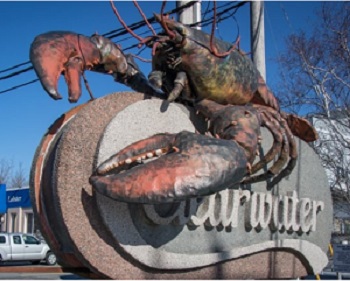 A crew member has died after an incident on a Clearwater Seafoods vessel in eastern Nova Scotia, the province’s Department of Labour confirmed Saturday. The department says it was notified of the death Thursday, and a stop-work order is in place as officials investigate what happened. The death is the second workplace fatality in Nova Scotia this week. Christine Penney, a spokesperson for Clearwater Seafoods, said the incident took place Thursday on board the Anne Risley, which is a company vessel that has been undergoing annual maintenance refits in Mulgrave, N.S. More, >>click to read<< 18:58
A crew member has died after an incident on a Clearwater Seafoods vessel in eastern Nova Scotia, the province’s Department of Labour confirmed Saturday. The department says it was notified of the death Thursday, and a stop-work order is in place as officials investigate what happened. The death is the second workplace fatality in Nova Scotia this week. Christine Penney, a spokesperson for Clearwater Seafoods, said the incident took place Thursday on board the Anne Risley, which is a company vessel that has been undergoing annual maintenance refits in Mulgrave, N.S. More, >>click to read<< 18:58
Canadian scallop quota valued at $200M sells to 3 Nova Scotia companies
 In a blockbuster seafood deal, St. John’s-based Ocean Choice International (OCI) has sold its Canadian offshore scallop quota, worth an estimated $200 million, to three Nova Scotia companies. Ocean Choice held 16.77 per cent of the offshore scallop quota, which is fished mostly on Georges Bank off southern Nova Scotia. A key driver in the sale was the sinking of the company’s factory trawler Atlantic Destiny on Georges Bank in March 2021. CEO Martin Sullivan says they opted not to replace it. “We were looking at our options and we talked to these three Nova Scotia companies that have been industry partners of ours for a long time.” more, >>click to read<< 08:08
In a blockbuster seafood deal, St. John’s-based Ocean Choice International (OCI) has sold its Canadian offshore scallop quota, worth an estimated $200 million, to three Nova Scotia companies. Ocean Choice held 16.77 per cent of the offshore scallop quota, which is fished mostly on Georges Bank off southern Nova Scotia. A key driver in the sale was the sinking of the company’s factory trawler Atlantic Destiny on Georges Bank in March 2021. CEO Martin Sullivan says they opted not to replace it. “We were looking at our options and we talked to these three Nova Scotia companies that have been industry partners of ours for a long time.” more, >>click to read<< 08:08
Wolastoqey fishers say proposed elver fishery shutdown infringes on treaty rights
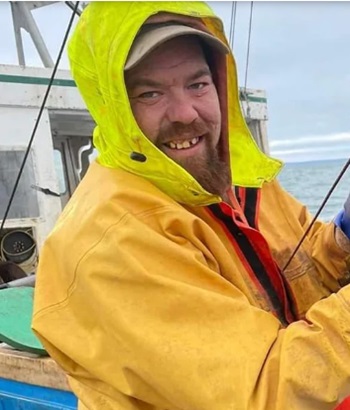 Some Wolastoqey fishers say closure of the fishery for baby eels, or elvers, this year will infringe on their treaty rights and impact their right to earn a moderate livelihood from fishing. Last week, Fisheries and Oceans Canada (DFO) issued letters to commercial licence holders that it will not renew licences ahead of the elver season that typically starts in late March. DFO shut down the elver fishery in New Brunswick and Nova Scotia last April because of conservation and safety concerns, after reports of violence and overfishing by unauthorized harvesters. Tyler Sabattis, a lobster and scallop fisherman, said he got into elver fishing last year to earn extra income for his family and community in Bilijk (Kingsclear First Nation), near Fredericton. more, >>click to read<< 09:34
Some Wolastoqey fishers say closure of the fishery for baby eels, or elvers, this year will infringe on their treaty rights and impact their right to earn a moderate livelihood from fishing. Last week, Fisheries and Oceans Canada (DFO) issued letters to commercial licence holders that it will not renew licences ahead of the elver season that typically starts in late March. DFO shut down the elver fishery in New Brunswick and Nova Scotia last April because of conservation and safety concerns, after reports of violence and overfishing by unauthorized harvesters. Tyler Sabattis, a lobster and scallop fisherman, said he got into elver fishing last year to earn extra income for his family and community in Bilijk (Kingsclear First Nation), near Fredericton. more, >>click to read<< 09:34
Champlain Seafood blames lack of lobsters for permanent closure of Meteghan, N.S., processing plant
 A lobster processing plant in Meteghan, N.S., is shutting down permanently saying there are “not enough lobsters to sustain current processing capacity.” In a news release sent out on Tuesday, Champlain Seafood announced Riverside Lobster International (RLI) will not reopen for the upcoming spring season and will close permanently. The company said the closure will not impact its New Brunswick processing plants, notably Cape Bald Packers and Captain Dan’s. “The reason for the temporary shutdown was due to lower lobster landings and overall product availability,” said Champlain Seafood spokesperson Rachelle Gagnon. “The lobster processing industry in Atlantic Canada is continuing to see an unprecedented situation.” more, >>click to read<< 15:07
A lobster processing plant in Meteghan, N.S., is shutting down permanently saying there are “not enough lobsters to sustain current processing capacity.” In a news release sent out on Tuesday, Champlain Seafood announced Riverside Lobster International (RLI) will not reopen for the upcoming spring season and will close permanently. The company said the closure will not impact its New Brunswick processing plants, notably Cape Bald Packers and Captain Dan’s. “The reason for the temporary shutdown was due to lower lobster landings and overall product availability,” said Champlain Seafood spokesperson Rachelle Gagnon. “The lobster processing industry in Atlantic Canada is continuing to see an unprecedented situation.” more, >>click to read<< 15:07
Swordfish are moving north in Canadian waters
 “It’s still unclear whether this is becoming the new normal due to climate change or if the biomass will eventually shift back again as we think it did historically,” said Fisheries and Oceans Canada biologist Kyle Gillespie. Nineteen-hundred tonnes of swordfish were landed in Canada last year. Nearly a third of the swordfish were taken off Newfoundland, where longline fishing boats from Nova Scotia trailed kilometres of baited hooks throughout much of the summer. Gillespie said this is a rapid shift from the previous decade, when the entire Canadian catch was concentrated along the Scotian Shelf and Georges Bank off southern Nova Scotia. more, >>click to read<< 08:46
“It’s still unclear whether this is becoming the new normal due to climate change or if the biomass will eventually shift back again as we think it did historically,” said Fisheries and Oceans Canada biologist Kyle Gillespie. Nineteen-hundred tonnes of swordfish were landed in Canada last year. Nearly a third of the swordfish were taken off Newfoundland, where longline fishing boats from Nova Scotia trailed kilometres of baited hooks throughout much of the summer. Gillespie said this is a rapid shift from the previous decade, when the entire Canadian catch was concentrated along the Scotian Shelf and Georges Bank off southern Nova Scotia. more, >>click to read<< 08:46
Scotian Shelf shrimp fishery braces for another cut
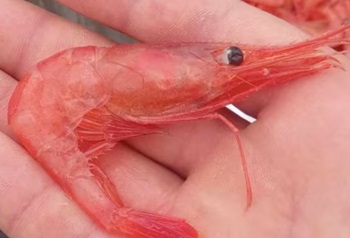 For a third straight year, the shrimp fishery off eastern Nova Scotia is facing a big quota cut with ocean conditions to blame. The recent scientific assessment for northern shrimp on the eastern Scotian Shelf showed environmental factors — including warmer ocean water due to climate change — are contributing to the poor condition of the stock, he says. And the response, he predicts, will be a reduction in the total allowable catch. The Department of Fisheries and Oceans (DFO) is expected to announce the 2024 shrimp quota in several weeks. more, >>click to read<< 10:59
For a third straight year, the shrimp fishery off eastern Nova Scotia is facing a big quota cut with ocean conditions to blame. The recent scientific assessment for northern shrimp on the eastern Scotian Shelf showed environmental factors — including warmer ocean water due to climate change — are contributing to the poor condition of the stock, he says. And the response, he predicts, will be a reduction in the total allowable catch. The Department of Fisheries and Oceans (DFO) is expected to announce the 2024 shrimp quota in several weeks. more, >>click to read<< 10:59
Five people, three companies convicted of 18 violations in N.S. halibut fishery
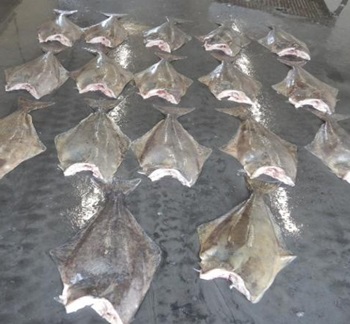 A major investigation into the halibut fishery in the Sambro area of Nova Scotia has led to multiple fines and licence suspensions. Five people and three companies were convicted of 18 violations of the Fisheries Act and Regulations. The Department of Oceans and Fisheries (DFO) conducted the investigation, according to a Tuesday news release.DFO originally laid 66 charges against eight individuals and five companies in 2021. “Harvesters who break the law give themselves an unfair advantage, undermine the effective management of the fishery, and threaten the sustainability of our shared fishery resources,” says DFO in the release. Links, more, >>click to read<< 10:43
A major investigation into the halibut fishery in the Sambro area of Nova Scotia has led to multiple fines and licence suspensions. Five people and three companies were convicted of 18 violations of the Fisheries Act and Regulations. The Department of Oceans and Fisheries (DFO) conducted the investigation, according to a Tuesday news release.DFO originally laid 66 charges against eight individuals and five companies in 2021. “Harvesters who break the law give themselves an unfair advantage, undermine the effective management of the fishery, and threaten the sustainability of our shared fishery resources,” says DFO in the release. Links, more, >>click to read<< 10:43
Clearwater Seafoods loses redfish quota as other Indigenous harvesters gain
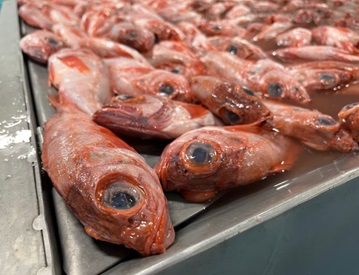 Indigenous-owned Clearwater Seafoods is on the losing side of the redfish quota cut handed to the Atlantic Canadian offshore fleet by the federal government last week. The Department of Fisheries and Oceans reduced the share of Gulf of St. Lawrence redfish quota held by Clearwater and other offshore licence holders by 20 per cent, in part to encourage Indigenous participation in the fishery. Commercial harvesting will restart this year, marking an epic comeback from a collapse 30 years ago to a population now estimated at 2.2-million metric tonnes. Offshore companies spent tens of millions of dollars gearing up for the return only to lose a big piece of their quota on the eve of reopening. photos, more, <<click to read<< 14:11
Indigenous-owned Clearwater Seafoods is on the losing side of the redfish quota cut handed to the Atlantic Canadian offshore fleet by the federal government last week. The Department of Fisheries and Oceans reduced the share of Gulf of St. Lawrence redfish quota held by Clearwater and other offshore licence holders by 20 per cent, in part to encourage Indigenous participation in the fishery. Commercial harvesting will restart this year, marking an epic comeback from a collapse 30 years ago to a population now estimated at 2.2-million metric tonnes. Offshore companies spent tens of millions of dollars gearing up for the return only to lose a big piece of their quota on the eve of reopening. photos, more, <<click to read<< 14:11
Ottawa revamps redfish allocation in Gulf of St. Lawrence, but N.S. keeps largest share
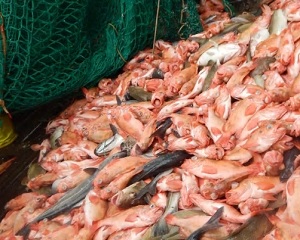 Following months of anticipation and lobbying in Quebec, Newfoundland and Labrador, and Nova Scotia, the federal government has announced how it will allocate fishing access to the redfish population in the Gulf of St. Lawrence. The allocations were announced on Friday by Fisheries Minister Diane Lebouthillier at a news conference in Gaspé, Que. Under the new terms, Nova Scotia will continue to receive the largest portion of the allocation, but it appears the province has received in the past will decline. It is unclear by how much. more, >>click to read<< 15:55
Following months of anticipation and lobbying in Quebec, Newfoundland and Labrador, and Nova Scotia, the federal government has announced how it will allocate fishing access to the redfish population in the Gulf of St. Lawrence. The allocations were announced on Friday by Fisheries Minister Diane Lebouthillier at a news conference in Gaspé, Que. Under the new terms, Nova Scotia will continue to receive the largest portion of the allocation, but it appears the province has received in the past will decline. It is unclear by how much. more, >>click to read<< 15:55






